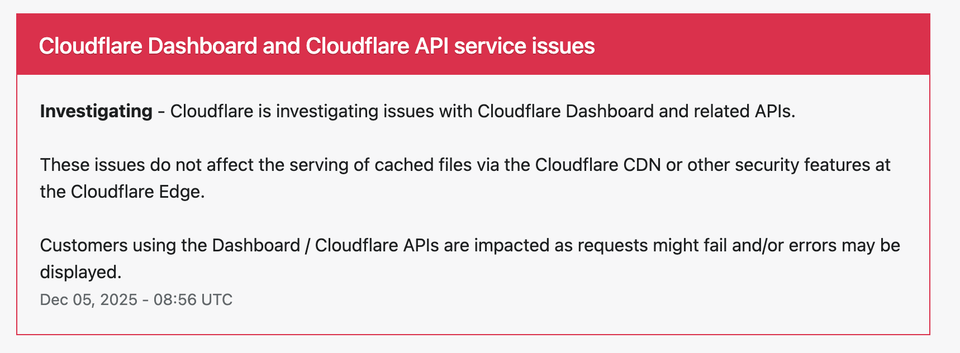⚙️ Technologies Affected by the AWS US-EAST-1 Outage (October 20, 2025)
Explore every AWS technology impacted by the October 2025 US-EAST-1 outage — from DNS and EC2 to CloudWatch, IAM, and Lambda. Learn how interdependent cloud systems respond to cascading failures.

🧠 1. Core Networking and DNS Infrastructure
The outage originated from a DNS resolution issue, which propagated through AWS’s internal and external systems.
DNS is the foundation of AWS service communication, and failures caused multiple dependent systems to lose connectivity.
🧩 Affected Technologies:
- DNS (Domain Name System) – Root cause of the outage
- Amazon Route 53 – AWS’s DNS and domain management system
- Internal Service Discovery DNS – Used by microservices inside AWS
- Network Load Balancing (NLB)
- Application Load Balancing (ALB)
- Elastic Load Balancing (ELB) – Dependent on DNS for endpoint resolution
- VPC (Virtual Private Cloud)
- VPC Lattice – Service mesh communication layer
- NAT Gateway – Outbound internet routing
- Transit Gateway – Multi-VPC communication
- PrivateLink (VPCE) – Private network endpoints dependent on internal DNS
- VPN Connections (Site-to-Site VPN) – DNS lookups for authentication endpoints
🧠 Impact:
- Internal and external DNS lookups failed or timed out.
- Load balancers couldn’t route traffic correctly.
- EC2 and Lambda instances failed to locate APIs or database endpoints.
🖥️ 2. Compute and Virtualization Layer
The compute infrastructure experienced partial failures due to broken service dependencies and unresolved network endpoints.
🧩 Affected Technologies:
- Amazon EC2 (Elastic Compute Cloud) – Instance launch and scaling delays
- Amazon ECS (Elastic Container Service) – Container scheduling impacted
- Amazon EKS (Elastic Kubernetes Service) – Pod communication failed
- AWS Batch – Queued workloads delayed
- Auto Scaling Groups – Failed to create new instances due to unresolved API calls
- AWS Parallel Computing / HPC Systems – Dependent on EC2 launch stability
🧠 Impact:
- New EC2 instances failed to launch or register.
- Auto Scaling and container orchestration were partially suspended.
- Lambda invocation and SQS triggers stalled.
🗄️ 3. Data and Database Technologies
Data persistence and replication were among the hardest hit due to dependency on DynamoDB and IAM, both affected by DNS resolution.
🧩 Affected Technologies:
- Amazon DynamoDB – Central data service and main disruption source
- Amazon RDS (Relational Database Service) – Dependent on EC2 and IAM
- Amazon Aurora (DSQL) – High-availability replication affected
- Amazon ElastiCache – Redis/Memcached endpoints failed to resolve
- Amazon DocumentDB – MongoDB-compatible clusters delayed
- Amazon Neptune – Graph database with API dependencies
- Amazon Redshift – Analytics queries delayed due to IAM auth lag
- AWS Database Migration Service (DMS) – Endpoint communication failures
- AWS Glue – ETL jobs failed due to missing endpoints
- Amazon FSx – File systems with network dependencies delayed
🧠 Impact:
- API timeouts and delayed database replication.
- Write operations queued or failed.
- Data pipelines (Glue, DMS) temporarily halted.
📡 4. Messaging and Event-Driven Architectures
The outage disrupted asynchronous communication between AWS services — particularly event-triggered systems like Lambda, SQS, and EventBridge.
🧩 Affected Technologies:
- Amazon SQS (Simple Queue Service) – Message processing backlog
- Amazon SNS (Simple Notification Service) – Event delivery delays
- AWS Lambda – Failed triggers from SQS and DynamoDB streams
- AWS EventBridge – Delayed rule execution and event publishing
- AWS CloudTrail – Event logging backlog
- AWS Step Functions – Workflow failures for dependent Lambdas
🧠 Impact:
- Event-driven apps experienced multi-minute delays.
- Lambda SQS polling recovered late (around 5:10 AM PDT).
- Backlogged events processed after DNS mitigation.
🧰 5. Security, Identity, and Access Management
AWS identity services depend on DNS and DynamoDB, making authentication globally inconsistent during the outage.
🧩 Affected Technologies:
- AWS Identity and Access Management (IAM)
- AWS IAM Identity Center (SSO)
- AWS Security Token Service (STS) – Temporary credential issuance failed
- AWS Private Certificate Authority (CA)
- AWS Verified Access
- AWS Organizations – Policy updates delayed
- Amazon GuardDuty / Security Lake – Telemetry ingestion lag
🧠 Impact:
- Authentication and API calls failed intermittently.
- IAM role propagation delayed across regions.
- Security monitoring gaps during the incident.
☁️ 6. Networking and Connectivity Services
Several connectivity services suffered temporary degradation, especially those relying on DNS for route resolution.
🧩 Affected Technologies:
- Amazon CloudFront – CDN endpoints unreachable for some users
- AWS Global Accelerator – Latency in rerouting traffic
- AWS Network Firewall – Inconsistent rule propagation
- AWS Elastic Load Balancing (NLB, ALB) – Dependent on DNS for targets
- AWS Site-to-Site VPN – Authentication and connection issues
🧠 Impact:
- Cross-region traffic routing delays.
- CDN and edge workloads experienced packet loss.
🤖 7. Developer and Management Tools
AWS’s internal orchestration and management services also saw degradation.
🧩 Affected Technologies:
- AWS CloudFormation – Stack updates delayed
- AWS Systems Manager (SSM) – Automation and Run Command failures
- AWS Config – Delayed compliance evaluations
- AWS CodePipeline / CodeBuild – Build jobs stalled
- AWS Application Migration Service – Failover operations impacted
🧠 Impact:
- CI/CD pipelines stalled.
- Infrastructure-as-code (IaC) operations delayed or stuck.
📊 8. Observability, Monitoring, and Logging
Monitoring systems were heavily affected early in the incident due to API dependencies.
🧩 Affected Technologies:
- Amazon CloudWatch – Metric ingestion delayed
- AWS CloudTrail – API activity logging backlog
- AWS X-Ray – Distributed tracing interruptions
- AWS Health Dashboard – Partial delays in health event propagation
🧠 Impact:
- Missing or delayed telemetry data.
- Difficulty diagnosing active issues.
🧠 9. Machine Learning, AI, and Analytics
AI workloads and analytics pipelines were temporarily slowed due to dependencies on storage and network services.
🧩 Affected Technologies:
- Amazon SageMaker – Model training delays
- Amazon Kinesis Data Streams / Video Streams – Event lag
- Amazon OpenSearch Service – Cluster communication errors
- Amazon Athena – Query execution delays
- Amazon Managed Workflows for Apache Airflow (MWAA) – Job execution stalled
- Amazon QuickSight – BI dashboards failed to refresh
🧠 Impact:
- ML model pipelines delayed or paused.
- Real-time analytics streams interrupted.
💼 10. Business and End-User Services
User-facing applications also experienced instability.
🧩 Affected Technologies:
- Amazon WorkSpaces – Delayed desktop provisioning
- Amazon WorkMail – Email routing issues
- Amazon Chime – Real-time communication interruptions
- Amazon Pinpoint – Marketing automation and analytics affected
- Amazon Q Business – AI assistant with degraded access to backend APIs
🧩 11. Underlying Cloud Technologies Impacted
Beyond AWS service names, the outage affected several core cloud architecture layers:
| Layer | Technologies Impacted | Description |
|---|---|---|
| Networking | DNS, Route 53, VPC Lattice | Root cause; service discovery broken |
| Compute | EC2, Lambda, ECS | Provisioning and scaling failures |
| Storage | DynamoDB, RDS, FSx | API access and data writes delayed |
| Orchestration | CloudFormation, Systems Manager | Automation halted |
| Security | IAM, STS, GuardDuty | Auth and telemetry lag |
| Observability | CloudWatch, CloudTrail, EventBridge | Monitoring backlogs |
| Edge Services | CloudFront, Global Accelerator | Regional latency and delivery issues |
🧭 Summary
This single regional outage demonstrated how deeply interdependent AWS technologies are.
The root cause — a DNS resolution failure — propagated upward, affecting every layer from networking and authentication to data storage and serverless compute.
AWS mitigated the problem within hours, but the event underscores a crucial truth:
In cloud computing, even a low-level dependency like DNS can ripple across dozens of critical technologies — proving that reliability begins at the foundation.
If you want to understand cloud resilience, AWS internals, and how to design DNS-tolerant systems,
visit 👉 dargslan.com — your trusted hub for advanced IT learning, infrastructure design, and DevOps education.




